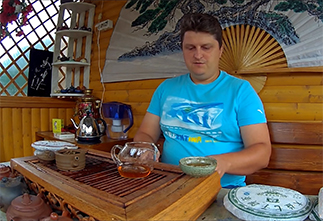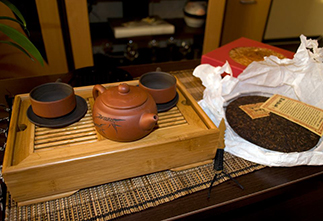Shu Puer 2018 "Winter Solstice" by Chashuwan: a warm winter drink
Shu Puer 2018 "Winter Solstice" from the Chashuwan factory is an exquisite example of traditional Yunnan puer, created to warm you up on cold days. Aged for six years, this tea has acquired a soft, rounded taste and aroma that warm the body and soul.
The winter solstice is an astronomical event occurring on December 21, when the Sun reaches its lowest declination relative to the celestial equator. It is the shortest day of the year, after which daylight hours begin to gradually increase. In various cultures, the winter solstice was associated with rebirth, rebirth, and the beginning of a new cycle.
The winter solstice, despite its cold association, symbolizes the beginning of a new cycle, the rebirth of life. Shu puer, especially aged, has a warming effect, tones the body and gives strength. Thus, tea, like the winter solstice, carries the energy of renewal and life.
History of creation and features
Chashuvan Tea Factory is famous for its high-quality pu-erhs, which are produced using traditional technologies. Shu Pu-erh "Winter Solstice" is the result of many years of experience and skill of tea masters. To create it, raw materials grown in ecologically clean areas of the Xishuangbanna-Dai Autonomous Region were used. Careful fermentation in heaps allowed to obtain tea with a bright, rich taste and multifaceted aroma.
- Manufacturer: Chashuwan (Chinese: 茶树王, pinyin: Cháshù wáng) is one of the famous pu-erh producers in China.
- Name: Winter Solstice Pu'er (ripe) - "Winter Solstice" Pu'er (ripe). The name is associated with the time of harvesting the raw material and the warming effect of the tea.
- Raw materials: High-quality tea leaves grown in ecologically clean areas of Xishuangbanna.
- Fermentation: Traditional heap fermentation.
- Pressing: Pancake weighing 357 grams.
- Year of production: 2018.
Taste and aroma
Shu Puer "Winter Solstice" has a soft, woody taste with light fruity notes. The aroma of the tea is warm, cozy, with shades of dried fruits and nuts. When brewed strongly, some acidity appears, which gives the tea additional brightness.
Beneficial properties
Like other types of puer, Shu Puer "Winter Solstice" has a number of beneficial properties:
- Improving digestion: Promotes normal digestion and metabolism.
- Toning the body: Increases vitality and vigor.
- Antioxidant properties: Protects the body's cells from the harmful effects of free radicals.
- Beneficial effects on the cardiovascular system: Helps lower cholesterol levels and improve blood circulation.
How to brew
To brew this puer, it is recommended to use a Yixing clay teapot or porcelain gaiwan. The water temperature should be about 95°C. 7-10 grams of dry tea leaves are enough for one brewing.
Why is it worth trying this pu-erh?
- High quality: Produced by one of the famous Chinese tea factories.
- Mild Taste: Ideal for those who prefer mild, delicate flavors.
- Warming effect: An excellent choice for the cold season.
- Beneficial properties: Has a beneficial effect on the body as a whole.
- Storage Potential: Shu pu-erhs only get better with age, making this tea a great investment.
Shu Puer 2018 "Winter Solstice" from Chashuwan is a real winter warming drink. Its soft, rounded taste and warm aroma will warm you up on cold days and give you a feeling of coziness.
|
Name in Chinese
|
冬至普洱茶(熟茶) |
|
Pinyin
|
dōngzhì pǔ'ěrchá shúchá |
|
Translation
|
Shu Puer Winter Solstice |
|
Country
|
China |
|
District
|
Xishuangbanna Dai Autonomous Prefecture |
|
Provinces
|
Yunnan (云南) |
|
Manufacturer
|
Чашуван (茶树王) |
|
Year of pressing
|
2018 |
|
Pressing form
|
Bing Cha (Cake Tea) |
|
Declared weight, g
|
357 |
- Комментарии
- Вконтакте
The question often arises: how to brew puerh correctly? Sometimes the phrase "to get high" is added to it. Moreover, everyone has their own understanding of this phrase. Some mean vigor, and some - intoxication. So how to brew puerh tea correctly? Let's consider several options.
Traveling through the tea mountains, we found ourselves in another land of blue roofs - the village of Zhongcai, which is located in the Menghai district of Yunnan province. According to tradition, we were shown another local tea tree, which, according to the Chinese, is at least a million years old :) The village is very authentic, not designed for tourists, there are many wild pu-erhs there and, of course, we were warmly received. They treated us to local cuisine and tea. We also asked the residents about the prices of tea and how they have changed in recent years.
The tea ceremony occupies a special place in the centuries-old Eastern tradition. And although the essence of this phenomenon remains constant, the nature and external manifestations of the tea ceremony in different nations have their own national characteristics. In each Chinese province, the tea ceremony and the tea used in it are varied: for example, residents of the southern provinces prefer green tea, and residents of the northern provinces - red tea, in Fujian province they more often use Oolong tea, and in Yunnan province Puer tea is widely known.





























































































